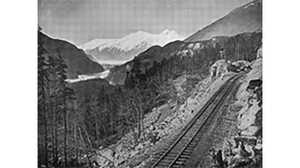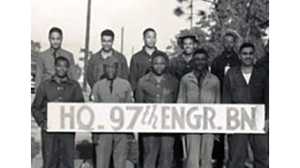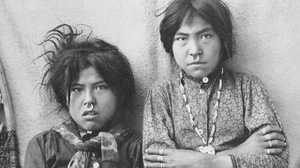Life of a Highway Builder
With Japan's attacks on Pearl Harbor and, later, the Aleutian Islands, fresh in the American consciousness in 1941 and 1942, the Army Corps of Engineers felt pressure to finish its work on the Alaska Highway as quickly as possible. The grueling schedule and extreme conditions made life difficult for the highway builders.

Cold or Hot and Buggy
Most of the men had never been exposed to weather as cold as Alaska's. In one of the most frigid autumns recorded in the area, skin would freeze in seconds. Each morning, before beginning their shift, the men would search each other's faces for white spots, signs that a problem was developing. Things were not much better in the summer. Temperatures soared in the perpetual sun, and the air was choked with dust. Worse still, the men had to fend off swarms of insects. The black flies were so thick that workers were constantly inhaling them. And then there were mosquitoes. "You had mosquitoes that dive-bombed you," described engineer Hayward Oubre.
Truth in Advertising
A contractor's recruiting poster described the unforgiving environment. Men sought by Bechtel-Price Callahan to set up an oil refinery along the route were required "to work and live under the most extreme conditions imaginable. Temperature will range from 90 degrees above zero to 70 degrees below zero. Men will have to fight swamps, rivers, ice and cold. Mosquitoes, flies and gnats will not only be annoying but will cause bodily harm. If you are not prepared to work under these and similar conditions, do not apply."
Outdoor Life
Because of the mobile nature of their work, the men were without comforts like working toilets and running water. The engineers constructed makeshift baths out of fifty-gallon drums; sometimes, they would brave the frigid water and bathe in nearby streams. When they reached a town, facilities were hardly better. Outhouses, known as "blackhouses," were in common use -- some of them multi-seaters so men could sit in rows. Sears-Roebuck and Eaton's catalogues were used as toilet paper.
Sustenance
Variety was not an option when it came to food. With transportation to the remote areas of Alaska and British Columbia unreliable at best, the men would often have to make do with what could be carried along. Pancakes and chili con carne were staples of the engineers' diet, with the workers often eating the same food three meals a day, every day, for weeks on end. Spam was regarded as an extravagance.
Urgent Pace
When the midnight sun provided twenty hours of daylight, the men worked in double shifts: half of the company worked in the morning and the other would take over at night. This frenetic pace continued every day, seven days a week. Often the men were required to travel ten miles from their encampment before they could begin the day's work.
Tents
The highway builders were constantly on the move, at a rate of eight miles per day. Substantial lodging did not exist. The men were issued tents, but they did not always have either the time or the energy to fully set them up. On rare occasions they would merely roll out their blankets and sleep in the snowdrifts.
Free Time
In their few off hours, the men had little choice other than to remain within the confines of their encampment. Each work unit was almost entirely isolated from contact with other units or civilians.Occasionally, they would come across a native village or a small town, but the builders were mostly left to themselves. To pass the hours, many went hunting and fishing with their military-issued guns, overwhelming native wildlife. When possible, films and performers from the USO were brought north for entertainment. A highway newspaper was published. Chaplains served the men; religious services were held each Sunday, and those who were not working would attend.
Ping Pong
Federal Investigator Ruth Gruber recalled the popularity of one activity at stationery Army Corps of Engineers camps: "Ping pong was very big in Alaska... They built a lot of clubhouses for the soldiers... And that was one of the real things that you did in Alaska... to spend time." Even during their off hours, however, the men often had work to do, particularly fighting brushfires that were constantly erupting.
Mission Accomplished
Despite the isolation, the grueling pace and the awful conditions, the Army Corps of Engineers completed the groundwork for the Alaska Highway in less than eight months. At the time, most soldiers were bitter about the experience, noting in particular that civilian workers doing the same jobs lived in better conditions and were paid high salaries. In retrospect, however, most of them were proud of their mission.
Service for Homeland Security
"It was a bitterly cold experience," explained military historian Charles Hendricks. "But when they were done, and for the rest of their lives -- these were young men -- they must've had a wonderful sense of accomplishment, a wonderful sense of meaningful service in a very difficult time. And they must've felt lucky to have been part of this awesome project."







